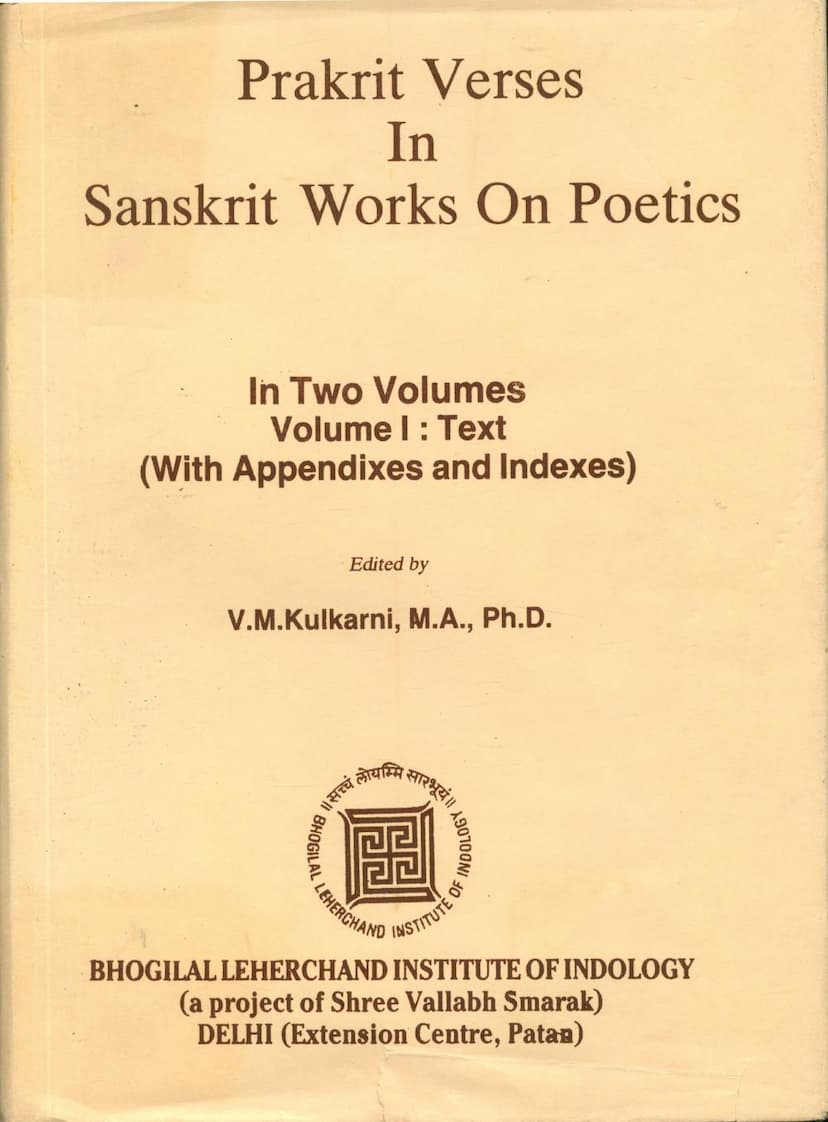Prakrit Verses In Sanskrit Works On Poetics Part 01
Added to library: September 2, 2025

Summary
Here's a comprehensive summary of the Jain text "Prakrit Verses in Sanskrit Works on Poetics Part 01" by V. M. Kulkarni:
Overall Purpose and Scope:
This book is the first volume of a two-volume work aiming to critically edit and present Prakrit and Apabhramsa verses that have been cited as illustrations in Sanskrit works on poetics. The editor, V. M. Kulkarni, identifies a long-felt need for such a critical edition, noting that many of these Prakrit and Apabhramsa passages are defectively edited in the original Sanskrit works. This volume focuses on the text of these verses, providing their Sanskrit chāyā (literal translation/transliteration into Sanskrit), along with appendices and indexes. Volume II is intended to contain the introduction, translation, critical and comparative notes, and a glossary.
Key Contributions and Methodology:
- Addressing a Scholarly Gap: The primary goal is to provide accurate and critical editions of over two thousand Prakrit and Apabhramsa passages found in Sanskrit works on poetics, many of which have been a source of despair for scholars due to their corrupted state.
- Tracing Sources: The editor makes an earnest attempt to present these passages in their correct form by tracing them to their original sources.
- Comparative Reference: When original sources are lost, the editor refers to other works on poetics, prosody, or grammar where these verses are cited, aiding in their restoration.
- Tentative Restoration: In cases where sources are lost, passages have been tentatively restored based on context, meter, and parallel ideas found in Sanskrit and Prakrit literature.
- Acknowledging Limitations: The editor candidly admits that some passages remain partially restored, and a considerable number that were a "despair" have been left as they are, with the hope that future material might allow for their restoration.
- Structure of Volume I: This volume is organized into twenty chapters, each dedicated to a specific work on Sanskrit poetics (including many standard and some lesser-known ones). The Prakrit and Apabhramsa passages from these works are presented along with their Sanskrit chāyā. Two appendices are dedicated to the Apabhramsa passages from Bhoja's Śrngāraprakāśa and Sarasvatikanthābharana, as corrected by Dr. H.C. Bhayani. The volume concludes with corrections and additions, chapter-wise alphabetical indexes of the Prakrit and Apabhramsa verses, and a supplement to the corrections.
Historical Context and Significance:
- Anandavardhana's Precedent: Anandavardhana, in his Dhvanyaloka, is identified as the first Sanskrit writer on poetics to use Prakrit verses as examples to explain concepts like dhvani, alamkara, bhāva, and rasa.
- Bhoja's Contribution: Bhoja, author of Śrngāra-Prakāśa and Sarasvatikanthābharaṇa, is highlighted for his unique distinction of citing over two thousand Prakrit and Apabhramsa passages.
- Richness of Prakrit Poetry: The editor expresses confidence that these two volumes will showcase the richness, excellence, and importance of Prakrit poetry and its significant place in Indian and even world poetry.
Scope of Prakrit and Apabhramsa Usage:
The book demonstrates how Prakrit and Apabhramsa verses were integral to the study and teaching of Sanskrit poetics. These verses were used to illustrate a wide range of poetic concepts, including:
- Dhvani (Suggestion): Anandavardhana's use of Prakrit to explain dhvani is noted as a starting point.
- Alamkara (Figures of Speech): Various figures of speech were elucidated with Prakrit examples.
- Bhava (Emotion) and Rasa (Aesthetic Sentiment): Prakrit verses were employed to explain and exemplify these fundamental concepts of Indian aesthetics.
- Language Classification: Rudrata is cited for enumerating and illustrating verses in Prakrit, Magadha, Paiśācī, Śūraseni, and Apabhramsa, demonstrating an early awareness and classification of these languages within the context of poetics.
- Linguistic Features: Commentators like Nami Sadhu also highlighted characteristic features of these languages when explaining the verses.
Key Works Covered (Volume I):
The volume covers Prakrit verses from twenty significant Sanskrit works on poetics, including:
- Rudrata's Kāvyālaṅkāra
- Anandavardhana's Dhvanyāloka (with Abhinavagupta's Locana commentary)
- Kuntaka's Vakroktijīvita
- Dhannañjaya's Daśarūpaka (with Dhanika's Avaloka)
- Mahimabhatta's Vyaktiviveka
- Bhoja's Śrngāraprakāśa
- Bhoja's Sarasvatikanthābharana
- Mammata's Kāvyaprakāśa
- Ruyyaka's Alaṅkārasarvasva (with Jayaratha's Vimarsini)
- Ruyyaka's Sahitya-Mimāṁsā
- Vagbhata's Vāgbhatālamkāra
- Hemacandra's Kāvyānuśāsana
- Anonymous author's Kalpalatāviveka
- Narendraprabha Sūri's Alaṅkāramahodadhi
- Vagbhata's (another one) Kāvyānuśāsana
- Viśvanātha's Sāhitya-Darpaṇa
- Simhabhūpāla's Rasārṇavasudhākara
- Sobhākara Mitra's Alaṅkāra-Ratnākara
- Jagannātha's Rasagangādhara (though primarily Sanskrit, it cites some Prakrit verses)
- Visveśvara Pandit's Alaṅkāra-Kaustubha
Editor's Background:
Dr. V. M. Kulkarni is presented as an accomplished scholar with extensive experience in teaching Sanskrit and Prakrit literature, Sanskrit poetics, and aesthetics. His contributions include numerous papers and articles in research journals and encyclopedias.
Publisher's Note:
The publisher expresses pleasure in presenting this work to scholars and thanks Professor Kulkarni for his "stupendous work done single-handed." Appreciation is also extended to the printer for making the volume attractive. The Ministry of Education, Central Government, New Delhi, is acknowledged for a substantial financial grant towards the publication.
In essence, Volume I of "Prakrit Verses in Sanskrit Works on Poetics" serves as a foundational collection, meticulously compiling and critically editing Prakrit and Apabhramsa verses used in the exposition of Sanskrit poetics. It aims to rectify textual inaccuracies and provide a reliable resource for scholars studying the interplay between these linguistic traditions and the development of Indian literary theory.